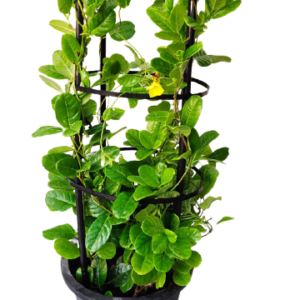Tristellateia australasiae, also known as the Forest Butterfly Vine or simply Tristellateia, is a climbing plant native to the tropical and subtropical regions of Southeast Asia and northern Australia. It is a member of the Apocynaceae family, which also includes popular plants like oleanders and frangipanis.
Landscape Use:
Tristellateia is often grown as an ornamental climbing vine in gardens and landscapes due to its attractive flowers and foliage.
It can be trained to climb on trellises, arbors, pergolas, or fences, creating a visually appealing vertical display.
The fragrant flowers of Tristellateia can attract pollinators like bees and butterflies to the garden.
Special Considerations:
Proper support is needed for the vine’s climbing habit.
It may require pruning to control its growth and maintain the desired shape.
Overall, Tristellateia australasiae (Forest Butterfly Vine) is a charming and visually captivating climbing plant that adds a touch of elegance and fragrance to gardens and landscapes. Its beautiful white flowers and glossy leaves make it an enchanting addition to trellises, arbors, or any vertical structure, creating a delightful and visually pleasing outdoor display.
Here’s an overview of Tristellateia australasiae:
Plant Characteristics:
Flowers: Tristellateia produces clusters of small, star-shaped, and fragrant white flowers. The flowers have five petals and are borne in terminal inflorescences, creating a beautiful display when in bloom.
Foliage: The leaves of Tristellateia are dark green, glossy, and arranged in opposite pairs along the stems. The leaves are elongated and lance-shaped with prominent veins.
Growth Habit: This climbing vine has twining stems that allow it to cling and grow upward. It can reach significant heights when supported by structures like trellises, fences, or other supports.
Cultural Requirements:
Light: Tristellateia thrives in full sunlight to partial shade. It prefers bright light conditions but can tolerate some shade.
Temperature: This vine is well-suited for warm and tropical climates. It does not tolerate frost and prefers temperatures above 50°F (10°C).
Watering: Tristellateia prefers regular watering to keep the soil consistently moist. It is essential to avoid waterlogging the soil, as excessive moisture can lead to root rot.
Soil: Well-draining, fertile soil is ideal for Tristellateia. The addition of organic matter can improve soil quality and drainage.
Fertilization: Regular fertilization during the growing season (spring and summer) with a balanced fertilizer can promote healthy growth and flowering.





